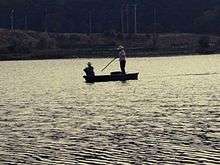East Lake (Wuhan)

East Lake (Chinese: 东湖; pinyin: Dōng Hú) is a large lake within the city limits of Wuhan, China, and the largest urban lake in China. Wuhan's East Lake covers an area of 88 square kilometers (33 square kilometers of water area[1]). It is one of the 5A tourist zones of China, and admits over a million people yearly. It is one of the largest sites in Huazhong District. It is also the largest "City Lake" in China. East Lake is made of four areas, Ting Tao, Mo Shan, Luo Yan Island and Museum of Hubei Province.
One end of Mo Shan features a Daoist temple built over the putative site of where one of the characters in "Romance of Three Kingdoms" performed special Qi Men Dun Jia rites before the famous battle of Red Cliffs. No one knows precisely the actual location, but the Mo Shan site was an archeological dig in the early part of the twentieth century.
Environmental issues
The lake was cut off from the Yangtze River in 1957. Water quality has deteriorated since because of 180,000 tons discharge of wastewater (domestic sewage and industrial) into the lake per day. Each year, about 441 tons of nitrogen and 40 tons of phosphorus are flow into the lake. Most parts of the lake have been assessed as eutrophicated, unsuitable for drinking and many recreational purposes.[2]
Notable sites around the lake

In clockwise order, starting from the southwest corner:
- Liyuan Park - a large urban park on the west side of the lake, with a popular free swimming area
- Hubei Provincial Museum
- Hubei Art Museum; the two museums are across the street from each other, just a block from the main entrance to Liyuan Park
- Wuhan Donghu Ocean Aquarium, proud of its flock of penguins[3]
- Wuhan Railway Station - a few km northeast of the lake
- Moshan ("Millstone Mountain") Scenic Area, including East Lake Cherry Blossom Park
- The "Chu Castle" (楚城)[4]
- Wuhan Botanical Garden
- East Lake Cherry Blossom Park
- China University of Geosciences, Wuhan Campus
- "Ba Yi" ("First of August") open-air swimming pool
- Houshan (Monkey Mountain) but no monkeys. One must travel to nearby Forest Park to see live monkeys, some un-caged.
- Wuhan University main campus
Several causeways cross the eastern part of the lake, providing access to recreational fishing sites and beaches. In 2012, the construction of a major 6-lane road under the lake (Donghu Tongdao) was started.[5] The Donghu Lake tunnel, China's longest tunnel under a lake, was open to traffic at the end of 2015. A car could run through the 10.6-kilometer-long tunnel in around 15 minutes.[6]
In 2010, plans for extensive new development on the lake shores caused widespread criticism among the citizenry.[7]
Image gallery
 In the Chu Castle
In the Chu Castle On one of the causeways
On one of the causeways A lotus pond near the botanical garden - the lotus seed ripening season
A lotus pond near the botanical garden - the lotus seed ripening season
Fishing
The East Lake has long been used by local fishermen. According to the 1977 statistics, the annual fish yield of the 1500-hectare fishing area of the lake ("The East lake Fish Farm") was 450 kg/ha.[8] The introduction of better fish management techniques have allowed the yields to increase in the following decade, with 1840 tons by 1995.[9]
The main species with which the lake is stocked are the silver carp and the bighead carp.[9]
See also
References
| Wikimedia Commons has media related to East Lake (Wuhan). |
- ↑ http://www.travelchinaguide.com/attraction/hubei/wuhan/donghu.htm
- ↑ https://idl-bnc.idrc.ca/dspace/bitstream/10625/16629/6/108377.pdf
- ↑ Little penguin in Wuhan aquarium, Xinhua, 2007-01-02
- ↑ Chu castle on Mo Mountain in Wuhan
- ↑ 图文:东湖通道开工 计划后年通车, 2012-10-28
- ↑ http://www.chinadaily.com.cn/china/2015-12/29/content_22848230.htm
- ↑ The Battle for East Lake in Wuhan, 13 April 2010
- ↑ American Oceanography Delegation, Committee on Scholarly Communication with the People's Republic of China (1980), Oceanography in China: a trip report of the American Oceanography Delegation submitted to the Committee on Scholarly Communication with the People's Republic of China, Issue 9 of CSCPRC report, Committee on Scholarly Communication with the People's Republic of China (U.S.)., National Academies, p. 13
- 1 2 Li, Wenhua (2001), "Fish farming in the East Lake (Dong Hu) of Wuhan", Agro-ecological farming systems in China, Volume 26 of Man and the biosphere series, Taylor & Francis, pp. 73–76, ISBN 92-3-103784-6
Coordinates: 30°34′N 114°23′E / 30.567°N 114.383°E